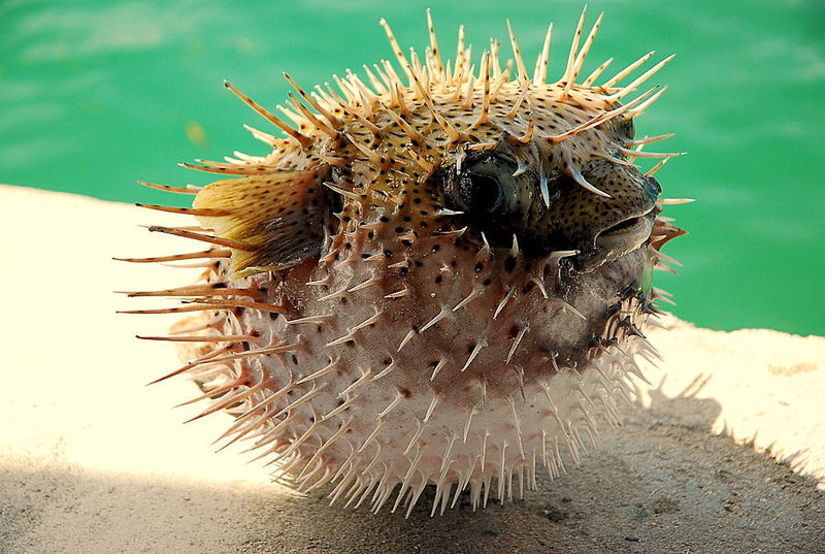Try It, If You Can! 10 The Most Weird Foods

One of the most exciting bits about travelling is trying out your favourite foods at the source.
If you’re a foodie adventurer, or looking for some tantalizing new ethnic dish to serve to guests, here are some of them.
1. Smalahove, Norway

Smalahove - is a Western Norwegian traditional dish made from a sheep’s head, originally eaten before Christmas. The name of the dish comes from the combination of the Norwegian words “hove” (head) and “smale” (sheep), so Smalahove literally means sheep head. The skin and fleece of the head is torched, the brain removed, and the head is salted, sometimes smoked, and dried. The head is boiled or steamed for about three hours, and is served with mashed rutabaga and potatoes.
2. Fugu Fish, Japan

One of Japan’s most elite delicacies is also one of the most dangerous dishes you’d ever put in your mouth. The fugu fish is a cute little fish, but grossly lethal, certainly. Fugu secretes a poison.
Currently, no type of anti-venom exists to undo what’s done from fugu poisoning. Regardless of the risk, in Japan’s most luxurious restaurants trained and licensed fugu chefs deftly prepare fugu for high society types, fugu aficionados, and culinary thrill seekers. Chefs adhere to strict preparation, sanitation, storage, and disposal guidelines to minimize risk.
3. Bull penis soup, Bolivia

Called Caldo de Cardan, this soup contains bull penis and testicles, which, by the way, looks exactly like a bull penis and testicles. For many, the meal is like an inexpensive all-purpose medication, helping to aid fatigue, anemia, and hangovers. Bull penis soup is considered an aphrodisiac.
4. Big Butt Ants, Colombia

In Colombia, Big Butt Ants, or Hormigas Culonas, are snacked on like cocktail nuts.
The preparation is a bit like a horror movie, as the ant is held in place, its head snapped quickly. Next, the wings and pincers are plucked, and the body is left to soak overnight in salt water before it is fried. The finished product tastes and chews like bacon bits. Some consider it an aphrodisiac.
5. Bat soup, Cambodia

One of the delicacies of Cambodia is bat soup, extremely popular in the district of Kandal Province. Like many Asian dishes, this particular soup is deemed to have medicinal qualities and is sometimes consumed as a remedy for certain ailments. For example, the presence of bats blood in the soup is said to help respiratory disorders and help cure any eye problem that you may have.
In local restaurants, the soup is prepared for you in much the same manner as a plate of fresh lobster would be prepared at a seafood restaurant on the Mediterranean. The waiter will present you with a cage of live bats from which you can choose that, that you would like to eat. Bat can be ordered cooked, in the form of soup, or eaten raw.
6. Eggs of turtles, Nicaragua

Eating sea turtles is a part of the culture in Nicaragua. Huevos de tortugas involves eating the eggs of turtles, which have a very soft shell.
A hole is made at the top of the raw egg, and hot sauce or lemon juice is squeezed in to help cure the concoction, followed by a shot of rum. Not only is the meal very odd, it’s also dangerous. When eating sea turtle eggs, you’re also ingesting toxins, bacteria, and pollutants.
7. Stink heads, Alaska, USA

Salmon is a staple of the native Alaskan diet and natives have traditionally used all parts of the fish. One of the traditional delicacies is fermented salmon heads. Colloquially the dish has earned the name “stink heads.” Essentially the heads of King salmon are buried in the ground in fermentation pits, put into plastic or wooden barrels, even plastic food storage bags, and left for a few weeks or more. The heads are then harvested and consumed.
8. Chicha de jora - corn and spit beer, Peru

Did you know that human saliva can ferment corn kernels? Chicha is a popular drink all across the Andes region, a beverage that dates back to the Inca times. Chicha de jora is an alcoholic Peruvian variant that’s made by people (usually, men) chewing the moistened corn kernels, spitting them out, letting them ferment and then boiling them to smithereens.
9. Octopus, Korea

Raw octopus is common as is still alive octopus, served straight-up on a plate or in a bowl. Octopus is exactly as you might imagine: rubbery, chewy and fairly tasteless. Regardless, the dish has been a valued part of Korea’s cuisine for centuries and is considered a vitality enhancer and a health food.
10. Llama brain, Bolivia

Revered for its low content of fat and very high content of protein, llama meat has gained worldwide attention in recent years and, back home in the high Andes of Bolivia the animal is still immensely revered. Llamas are used to cart around goods or tourists and for eat. Bolivians don’t waste even a single morsel of the highly nutritious animal, so llama brain is a popular dish.





















 English
English
 German
German
 French
French
 Spanish
Spanish
 Italian
Italian
 Norwegian
Norwegian
 Russian
Russian
 Dutch
Dutch